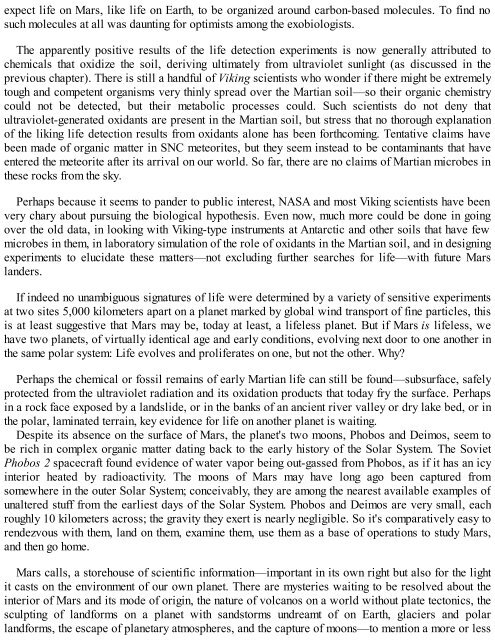Pale Blue Dot ( PDFDrive.com ) (1)
Create successful ePaper yourself
Turn your PDF publications into a flip-book with our unique Google optimized e-Paper software.
expect life on Mars, like life on Earth, to be organized around carbon-based molecules. To find no<br />
such molecules at all was daunting for optimists among the exobiologists.<br />
The apparently positive results of the life detection experiments is now generally attributed to<br />
chemicals that oxidize the soil, deriving ultimately from ultraviolet sunlight (as discussed in the<br />
previous chapter). There is still a handful of Viking scientists who wonder if there might be extremely<br />
tough and <strong>com</strong>petent organisms very thinly spread over the Martian soil—so their organic chemistry<br />
could not be detected, but their metabolic processes could. Such scientists do not deny that<br />
ultraviolet-generated oxidants are present in the Martian soil, but stress that no thorough explanation<br />
of the liking life detection results from oxidants alone has been forth<strong>com</strong>ing. Tentative claims have<br />
been made of organic matter in SNC meteorites, but they seem instead to be contaminants that have<br />
entered the meteorite after its arrival on our world. So far, there are no claims of Martian microbes in<br />
these rocks from the sky.<br />
Perhaps because it seems to pander to public interest, NASA and most Viking scientists have been<br />
very chary about pursuing the biological hypothesis. Even now, much more could be done in going<br />
over the old data, in looking with Viking-type instruments at Antarctic and other soils that have few<br />
microbes in them, in laboratory simulation of the role of oxidants in the Martian soil, and in designing<br />
experiments to elucidate these matters—not excluding further searches for life—with future Mars<br />
landers.<br />
If indeed no unambiguous signatures of life were determined by a variety of sensitive experiments<br />
at two sites 5,000 kilometers apart on a planet marked by global wind transport of fine particles, this<br />
is at least suggestive that Mars may be, today at least, a lifeless planet. But if Mars is lifeless, we<br />
have two planets, of virtually identical age and early conditions, evolving next door to one another in<br />
the same polar system: Life evolves and proliferates on one, but not the other. Why?<br />
Perhaps the chemical or fossil remains of early Martian life can still be found—subsurface, safely<br />
protected from the ultraviolet radiation and its oxidation products that today fry the surface. Perhaps<br />
in a rock face exposed by a landslide, or in the banks of an ancient river valley or dry lake bed, or in<br />
the polar, laminated terrain, key evidence for life on another planet is waiting.<br />
Despite its absence on the surface of Mars, the planet's two moons, Phobos and Deimos, seem to<br />
be rich in <strong>com</strong>plex organic matter dating back to the early history of the Solar System. The Soviet<br />
Phobos 2 spacecraft found evidence of water vapor being out-gassed from Phobos, as if it has an icy<br />
interior heated by radioactivity. The moons of Mars may have long ago been captured from<br />
somewhere in the outer Solar System; conceivably, they are among the nearest available examples of<br />
unaltered stuff from the earliest days of the Solar System. Phobos and Deimos are very small, each<br />
roughly 10 kilometers across; the gravity they exert is nearly negligible. So it's <strong>com</strong>paratively easy to<br />
rendezvous with them, land on them, examine them, use them as a base of operations to study Mars,<br />
and then go home.<br />
Mars calls, a storehouse of scientific information—important in its own right but also for the light<br />
it casts on the environment of our own planet. There are mysteries waiting to be resolved about the<br />
interior of Mars and its mode of origin, the nature of volcanos on a world without plate tectonics, the<br />
sculpting of landforms on a planet with sandstorms undreamt of on Earth, glaciers and polar<br />
landforms, the escape of planetary atmospheres, and the capture of moons—to mention a more or less


